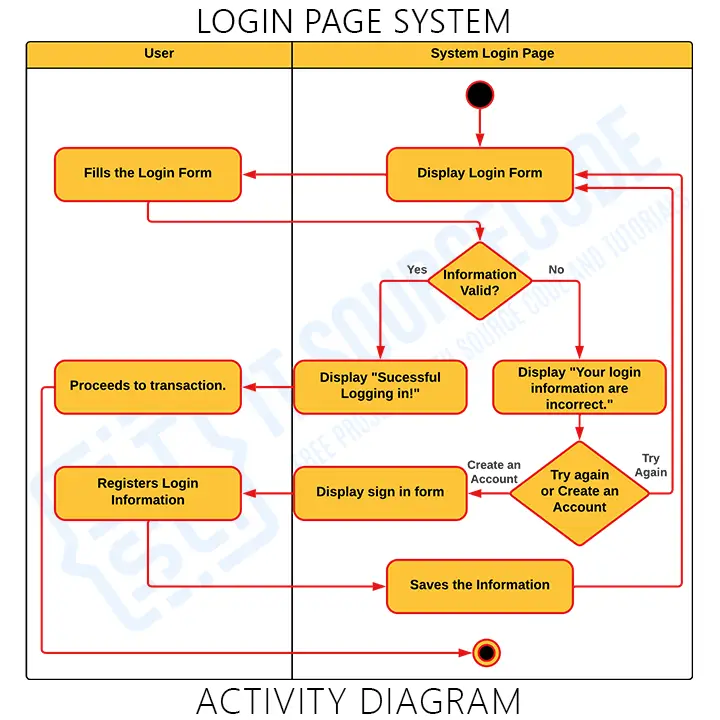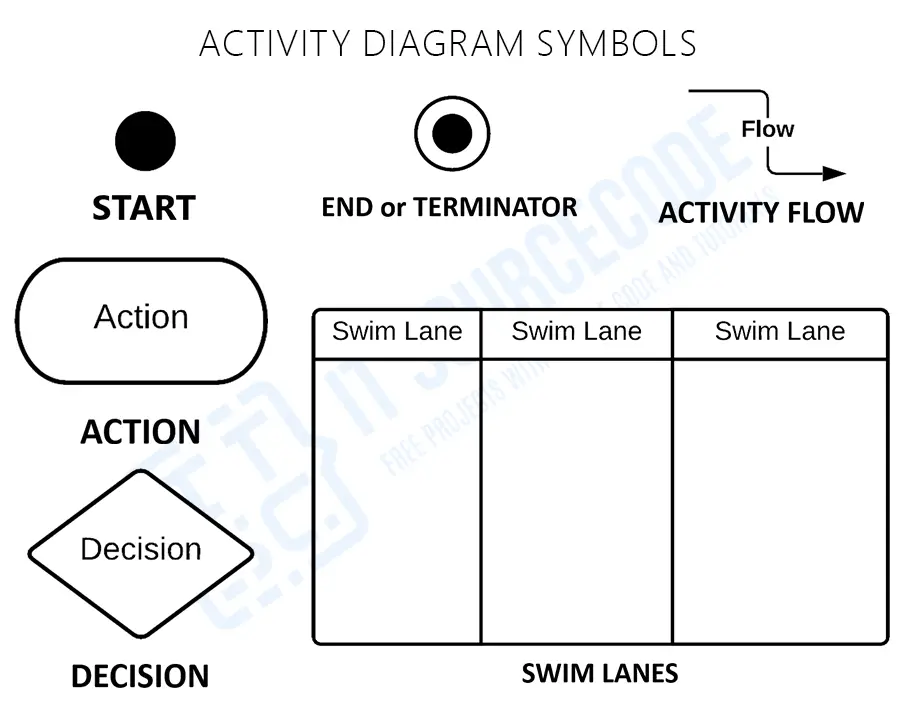Activity Diagram for Login Page – The flow of system activities is illustrated in the UML activity diagram for the login page system. It is one way to keep track of what people do when they log in to a system, which is important for its operation and development.
Additionally, the general workflow of the system’s login page is defined by symbols in the activity diagram. It is made up of actions, choices, and paths (flows).
Login Page Activity Diagram: Details
The project details for the activity diagram for the login page process are shown in the table. It has all of the information about the project.
| Name: | Login Page Activity Diagram |
| Abstract: | The login page process activity diagram represents the behavior of the project in terms of its activities. It contains the important details on the activities and constraints done in the project. |
| UML Diagram: | Activity Diagram |
| Users: | School Admin, Authorized Registrar Personnel, and Students or Registrees. |
| Tools Used: | Diagram tools that provide activity diagram symbols. |
| Designer: | ITSourceCode.com |
What is a Login Process?
A user registration system requires the creation of a username and password, as well as the answers to other security questions. Many user registration systems allow users to customize their accounts and profiles, while others give users their account information.
A user registration system asks for a username, a password, and the answers to some security questions. Many user registration systems let users customize their accounts and profiles, while others just give users their account information.
The user must sign up the first time they use the system. It’s a way to check a user’s credentials when they use the username and password they created when they signed up for the system for the first time to access and log on. So, “login” refers to the username and password that you need to use on a computer to get to its data.
Define the System’s Login Page Activity Diagram
A login page system activity diagram is what UML calls a very useful behavior diagram. This picture shows how the system and clients talk to each other. This is done by giving them different levels of detail about how the system works.
The UML activity diagram is a picture of a system’s login process. It shows a set of actions or control flows. In a use case diagram, it shows how the processes work. Its illustration can also be in order or at the same time.
Importance of UML Activity Diagram
When you use an activity diagram, you do the big things that make up the project’s workflow. These things depend on what the user decides, which makes the interaction work better. It also shows how a login process works by showing a set of steps or control flows.
In UML, an activity diagram shows the System’s Login Page’s most important tasks and rules. Then, these activities make a flow that should be part of the project. Each activity was correctly labeled so that the system’s behavior could be figured out.
The activity diagram is a UML diagram for the Login Page System. It also shows how the system changes over time. It shows how messages move from one task to the next.
Activity Diagram: Benefits
The Activity Diagram Benefits are as follows:
- Using an Activity Diagram, you can see how an algorithm works.
- It also talks about the steps a UML use case goes through.
- In a process or workflow, it shows how users and the system work together.
- Define hard use cases to make a process easier to follow and better.
Login Page System Activity Diagram
The example of a Login Page System Activity Diagram shows how the system works. This example of an activity diagram with swimlanes is shown in detail to help programmers understand it.
It figures out what a user does when they log in to a system. This example shows some of the things that happen when you book something online. So, the focus here was on the actions and choices that were made.

We used the swimlane with two walls, as shown in the picture. The user lane is shown on the left. It goes over everything a user could do when using the system. Its lane also shows how far the user can go in what they do.
Activity Diagram for Login Page Pdf
What’s going on? Symbols are used not only to make an activity diagram, but also to show what each part of the system’s process does. Every symbol was used to show a different part of the system.
What are the Symbols used in Activity Diagram?
The Activity Diagram Symbols are used not only to draw an activity diagram but also to emphasize the role of everything in the system’s process. Each of the symbols was used to show a certain part of the system.

- Start – is the beginning of the action. It uses a filled circle symbol to show its function.
- Action – is a stage of an activity in which users or software accomplish a certain task. Action is shown in Round-edged rectangles.
- Decision – symbolizes a conditional branch in the flow. It has two or more outputs and a single input. A diamond symbol presents this notation.
- Swim Lanes – are the lanes showing the actor’s boundaries. The activities drew in the same lane considered as the organization’s activities. Swim lanes must be in a logical arrangement.
- Activity Flow – is another name for the connectors in the diagram that illustrate the flow between processes (activity).
- End (Terminator) – is the last phase of the activity. An indicated black circle represents the final node.
How to Draw an Activity Diagram?
Time needed: 5 minutes
Here are the steps for making the activity diagram for the system login page.
- Step 1: Familiarize Activity Diagram Symbols
To make an activity diagram, you need to first learn the symbols that are used. With the symbols, you can talk about how activities and interactions flow through the system. Programmers can also quickly explain to users what the system is all about.
- Step 2: Identify the flow of actions.
After getting used to the symbols, you will need to figure out how the actions go from one to the next. Your use case diagram would show how things would happen.
- Step 3: Add the Actors (users) involved.
Actors do things to them, changing them into other things or changing how they are. This actor is something or someone outside of the system that interacts with the system.
- Step 4: Trace the flow of activities.
To figure out how things work, you need to know that flows can be run, branched, or sequential.
Conclusion:
In the end, we’ve talked about what an Activity Diagram for Login Page System is and how to put one together. This activity diagram is one of the ways that the login page for the system was made.
Related Articles:
- Login System DFD Diagram
- ER Diagram for Login Process
- Class Diagram for Login System
- Login Use Case Diagram
- Sequence Diagram for Login System
Inquiries
If you have any inquiries or suggestions about the given example of the Activity Diagram for Login Page, just leave us your comments below. We would be glad to hear your concerns and suggestions and be part of your learning.
Keep us updated and Good day!

